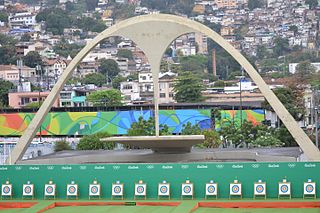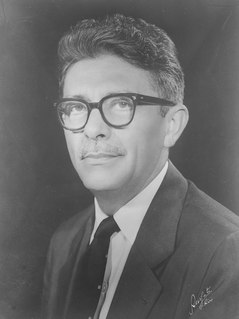
Brasília is the federal capital of Brazil and seat of government of the Federal District. The city is located at the top of the Brazilian highlands in the country's Central-West region. It was founded by President Juscelino Kubitschek on 21 April 1960, to serve as the new national capital. Brasília is estimated to be Brazil's third-most populous city. Among major Latin American cities, it has the highest GDP per capita.

Oscar Ribeiro de Almeida Niemeyer Soares Filho, known as Oscar Niemeyer, was a Brazilian architect considered to be one of the key figures in the development of modern architecture. Niemeyer was best known for his design of civic buildings for Brasília, a planned city that became Brazil's capital in 1960, as well as his collaboration with other architects on the headquarters of the United Nations in New York. His exploration of the aesthetic possibilities of reinforced concrete was highly influential in the late 20th and early 21st centuries.

Asturias, officially the Principality of Asturias, is an autonomous community in northwest Spain.

The Federal District is one of 27 federative units of Brazil. Located in the Center-West Region, it is the smallest Brazilian federal unit and the only one that has no municipalities, being divided into 31 administrative regions. The federal capital of Brazil, Brasília, which is also the seat of government of the Federal District, is located in its territory.
The year 1943 in architecture involved some significant architectural events and new buildings.

The Sambadrome Marquês de Sapucaí is a purpose-built parade area built for the Rio Carnival in Rio de Janeiro, Brazil. The venue is also known as Passarela Professor Darcy Ribeiro or simply the Sambódromo in Portuguese or Sambadrome in English. It is located in the downtown area of Cidade Nova in Rio de Janeiro, and is the place where samba schools parade competitively each year during the Rio Carnival. The parades attract many thousands of Brazilians and foreign tourists each year, and the structure is also used as a multi-purpose performance venue. The structures of the Sambadrome were designed by the architect Oscar Niemeyer (1907–2012), and represent his first major work after the end of the Brazilian dictatorship of 1964–1985.

The Palácio do Planalto in Brasília is the official workplace of the president of Brazil. The building was designed by architect Oscar Niemeyer in 1958 and inaugurated on April 21, 1960. It has been the workplace of every Brazilian president since Juscelino Kubitschek. It is located at the Praça dos Três Poderes, to the east of the National Congress of Brazil and across from the Supreme Federal Court.

The Palácio da Alvorada is the official residence of the President of Brazil. It is located in the national capital of Brasília, on a peninsula at the margins of Paranoá Lake. The building was designed by Oscar Niemeyer and built between 1957 and 1958 in the modernist style. It has been the residence of every Brazilian president since Juscelino Kubitschek. The building is listed as a National Historic Heritage Site.

The Gustavo Capanema Palace, also known architecturally as the Ministry of Education and Health Building, is a government office building in the Centro district of Rio de Janeiro, Brazil. As the first modernist project in Brazil, it is historically important to the architectural development of Modernism in Brazil and has been placed on Brazil's UNESCO tentative list.

The Ibirapuera Auditorium is a building conceived by Oscar Niemeyer for the presentation of musical spectacles, situated in Ibirapuera Park in São Paulo.

The Jabiru's Palace is the official residence of the Vice President of Brazil. The building was designed, along with the rest of the city of Brasília, by Oscar Niemeyer and inaugurated in 1977. It is located near the Palácio da Alvorada in Brasília. The name comes from a common bird of the region, the Jabiru.

The Apotheosis Square is a venue in Rio de Janeiro close to the Morro da Mineira favela. It is part of Sambadrome Marquês de Sapucaí, which can hold a maximum 90,000 people. For concerts, it can hold from 10,000 to 40,000 people.

The Latin America Memorial is a cultural, political and leisure complex, inaugurated in 1989, in São Paulo, Brazil. The architectural setting, designed by Oscar Niemeyer, is a monument to the cultural, political, social and economic integration of Latin America, spanning an area of 84,482 square meters. Its cultural project was developed by Brazilian anthropologist Darcy Ribeiro. It is a public foundation, financially and administratively autonomous, maintained by the state government.

Óscar Raúl Ugarte Ubilluz is a Peruvian physician who is the current Minister of Health under President Francisco Sagasti since 13 February 2021. He previously held the position under President Alan García from October 2008 to July 2011.

The Itamaraty Palace, also known as the Palace of the Arches, is the headquarters of the Ministry of Foreign Affairs of Brazil. It is located in the national capital of Brasília. The building was designed by architect Oscar Niemeyer and inaugurated on April 21, 1970. It is located to the east of the National Congress building along the Ministries Esplanade, near the Praça dos Três Poderes.

Events in the year 1948 in Brazil.

Anna Maria Baldo Niemeyer was a Brazilian architect, furniture designer and gallery owner. The only daughter of Oscar Niemeyer, she worked with her father to design the civic buildings for Brasília, focusing primarily on interior spaces and decoration. When her father decided to make furniture to harmonize his structures with the design elements, she turned her interest to furniture designing. Her two most noted designs were the initial prototype called the "Alta" and the "Rio". In her latter career, she ran an art gallery in Rio, which at one time was the only gallery in the city, and assisted in the creation of the Niterói Contemporary Art Museum.

Evandro Cavalcanti Lins e Silva was a Brazilian lawyer, journalist, writer and politician. He was Prosecutor General of the Republic, Chief of Staff, Minister of Foreign Affairs, and Justice of the Supreme Federal Court.

The 2018 Venezuelan protests began in the first days of January as a result of high levels of hunger by desperate Venezuelans. Within the first two weeks of the year, hundreds of protests and looting incidents occurred throughout the country. By late-February, protests against the Venezuelan presidential elections occurred after several opposition leaders were banned from participating. Into March, the Maduro government began to crack down on military dissent, arresting dozens of high-ranking officials including former SEBIN director Miguel Rodríguez Torres.



















